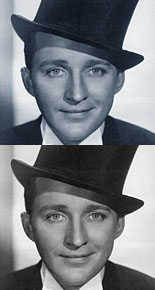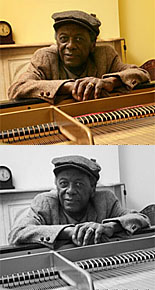Home » Jazz Articles » Old, New, Borrowed and Blue » Jazz Goes Green: Musical Explorations On A Secondary Color Of Note
Jazz Goes Green: Musical Explorations On A Secondary Color Of Note
 Benny Green
Benny Green Music has also had more than its fair share of run-ins with this secondary color of note. While one can toss off a list of artists with surnames born of this color, like the inimitably soulful Al Green, punk rock purveyors Green Day or swooning pop singer Jackie Greene, the relationship goes deeper. Yes, jazz also has its list of individuals who fall into this category—like the legendary guitarist Grant Green, big band trombonist Urbie Green, saxophonist Bunky Green and pianist Benny Green—but they had no control over their relationship with this color and were born into it. With all of its brilliant shades and hues, the color green has worked its way into the jazz color spectrum in countless ways and this month's Old, New Borrowed and Blue explores many of these relationships.
Old
When Bronislaw Kaper was commissioned to write the music for the 1947 film called Green Dolphin Street, it's doubtful that he could have imagined where the theme song would eventually go. This film is merely one entry on a long list of movies—including Gaslight (1944), Bataan (1943) and Mutiny On The Bounty (1962)—that feature music written by the Polish-born composer. Within ten years of its creation, the theme song for this motion picture—"On Green Dolphin Street"—would find new life in the world of jazz. While Miles Davis is often credited for crystallizing this song into the form that made it a jazz standard, other jazz musicians tackled it on record before he did (for example, the aforementioned Urbie Green), and an endless list of people have taken to it since Davis' version staked its claim. I happened to discover one of my favorite takes on this song while exploring drummer Roy Haynes' legacy. 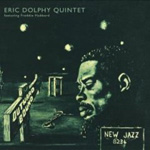 When A Life In Time: The Roy Haynes Story (Dreyfus Jazz, 2007) found its way onto shelves, I was tempted to buy it right away but I already owned a good amount of the material so I held off. About a year after its release, I gave into temptation and purchased this set and anxiously began digging into the music. While journeying through Haynes' recording career—enjoying recordings he made with Lester Young, Charlie Parker, Thelonious Monk, Oliver Nelson, John Coltrane and many others—I encountered a version of "On Green Dolphin Street" that he recorded with woodwind wizard Eric Dolphy. Outward Bound (Prestige, 1960) is just one of many extremely creative musical projects that Dolphy took part in—ranging from other leader dates to work with Charles Mingus, Coltrane and Nelson—but it gives the listening public an opportunity to hear what he does with one of the most popular jazz standards of the time.
When A Life In Time: The Roy Haynes Story (Dreyfus Jazz, 2007) found its way onto shelves, I was tempted to buy it right away but I already owned a good amount of the material so I held off. About a year after its release, I gave into temptation and purchased this set and anxiously began digging into the music. While journeying through Haynes' recording career—enjoying recordings he made with Lester Young, Charlie Parker, Thelonious Monk, Oliver Nelson, John Coltrane and many others—I encountered a version of "On Green Dolphin Street" that he recorded with woodwind wizard Eric Dolphy. Outward Bound (Prestige, 1960) is just one of many extremely creative musical projects that Dolphy took part in—ranging from other leader dates to work with Charles Mingus, Coltrane and Nelson—but it gives the listening public an opportunity to hear what he does with one of the most popular jazz standards of the time.
While he plays flute, bass clarinet and saxophone on this album—his first as a leader—he focuses on bass clarinet for this specific track. Bassist George Andrew Tucker and Dolphy are joined at the hip as they dole out a hip bass riff to start things off. As the song unfolds, this riff helps to underscore Freddie Hubbard's muted, nonchalant delivery of the melody. Dolphy takes control of the melody and then launches into an inspired flight over the rhythm section before handing it back to Hubbard. Haynes remains for Tucker's solo—providing some solid swing support—but everybody else sits this one out. While pianist Jaki Byard remains in a purely supportive role here, his tasteful comping—including his ascending little jabs as the song begins—adds volumes to this performance and Dolphy's take on this green giant-of-a-song deserves to be heard by a greater portion of the jazz listening public.
 New
New
In 2008, two of the most influential guitarists of their respective generations—and in all of jazz—got together to record a series of duo and quartet performances. Jim Hall and Bill Frisell, along with drummer Joey Baron and bassist Scott Colley, covered Sonny Rollins, Milt Jackson, Bob Dylan, Duke Ellington, a host of other great jazz composers and original material—written by individual participants or composed as collaborative efforts on Hemispheres (Artist Share, 2008). One of Hall's original compositions on the album gives both guitarists an opportunity to pay tribute to Count Basie's longtime guitarist, Freddie Green. The wording in the title of "Owed To Freddie Green" is an interesting twist on the way we hear things, with the word "Owed" substituted for "Ode." While the meaning would essentially be the same either way, this one little twist implies a more specific debt—as opposed to a song merely written in tribute—that all guitarists owe to one of the greatest rhythm guitarists that jazz has ever known.
The song itself is no mere imitation, musical retread or essay on older styles. Yes, Hall does begin the song with some four-to-the-bar strumming, à la Freddie Green, but then both guitarists start shooting phrases back and forth and becoming more interactive as Baron stirs it up with brushes and Colley's steady walking line holds it all together. After some longer guitar explorations and the back and forth lines again, Baron briefly takes control and takes the song home. When many people listen to Basie's recordings, they often overlook Green's subtle role in the rhythm section. While he rarely soloed, his steady strumming helped to keep the locomotive moving and create some of the greatest swing feels to ever show up on record. While Hall and Frisell are completely their own here, it's certainly nice to hear that these masters of jazz guitar have paid their debt to the great Freddie Green. Perhaps a future guitarist will give us an "ode" (or "owed") to Hall and Frisell.
Borrowed
When many children think of the color green, they can't help but think of Sesame Street's Kermit the Frog. This cute Muppet has been at the heart of children's television for several generations now and his song of amphibious alienation-turned-acceptance—"Bein' Green"—has been borrowed time and time again, becoming part of modern culture. Famed Sesame Street songsmith Joe Raposo is credited for writing the music and lyrics to this timeless treasure that has seeped from this youngster-driven television world into popular mainstream culture.
Michael Davis' Street Gang: The Complete History Of Sesame Street (Penguin, 2008), notes that many people interpreted the meaning of this song in different ways. He notes that "some people heard it as a contemplation of racial difference" or difference in general. He goes on to mention that Raposo's second wife—television personality Pat Collins—said that the song was "simply about being comfortable in your own skin, being comfortable with who you are." While the former interpretation might be what lead Ray Charles to comment that "he wished that he had written "Bein' Green," the latter reason seems to have lead vocalist Sophie Milman to tackle this song. 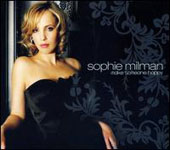 On Make Someone Happy (Koch, 2007), Milman touches on everything from Broadway to Randy Bachman, and she delivers a spellbinding take on Kermit's standard. When she performed this piece at the Montreal Jazz Festival in July of 2007, Milman discussed the difficulties of making friends and adjusting to a move-after-move lifestyle in her younger ears. As the rest of the band sat by and watched, Milman slowly peeled back the layers of the emotions that the song contains, with only pianist Paul Shrofel beneath her. After two minutes, the rest of the band joined in with subtle musical maneuvers that enhance her emotional expressions. Bassist Kieran Overs, lightly backed by the rest of the band, became the focal point as he began his solo and drummer John Fraboni lightly brushed below. Upon Milmans return, the piano work took on a bit more impressionistic qualities before things calmed down toward the end of the performance. Like Kermit, Milman has obviously gained comfort in her own skin and mass acceptance...as one of the brightest young singers in jazz.
On Make Someone Happy (Koch, 2007), Milman touches on everything from Broadway to Randy Bachman, and she delivers a spellbinding take on Kermit's standard. When she performed this piece at the Montreal Jazz Festival in July of 2007, Milman discussed the difficulties of making friends and adjusting to a move-after-move lifestyle in her younger ears. As the rest of the band sat by and watched, Milman slowly peeled back the layers of the emotions that the song contains, with only pianist Paul Shrofel beneath her. After two minutes, the rest of the band joined in with subtle musical maneuvers that enhance her emotional expressions. Bassist Kieran Overs, lightly backed by the rest of the band, became the focal point as he began his solo and drummer John Fraboni lightly brushed below. Upon Milmans return, the piano work took on a bit more impressionistic qualities before things calmed down toward the end of the performance. Like Kermit, Milman has obviously gained comfort in her own skin and mass acceptance...as one of the brightest young singers in jazz.
 Blue
Blue
It's not often that the United States Congress takes time to honor a jazz recording, but such an event occurred in December of 2009. Rep. John Conyers (D-Michigan) sponsored a bill to honor Miles Davis' Kind Of Blue (Columbia, 1959) on its 50th anniversary, and the resolution was unanimously passed. Like Kermit's anthem, this Miles Davis masterpiece has moved outside of its original niche and has become part of the cultural tapestry of America, and the World-At-Large. The songs on this album, from "All Blues" to "Freddie Freeloader" to "So What," all fall into the "classic" category and are required listening for all aspiring jazz musicians and fans.
The commercial success of this album and the easy-to-digest nature of the music have lead to mass appeal, but these compositions are also notable as universally-utilized maps for modal jazz exploration. In addition, these masterpieces serve to highlight the culmination of the collaborative relationship between Miles Davis and pianist Bill Evans. While Wynton Kelly had already moved into the piano chair in the Davis group when this album was recorded, Evans was called in for this session and Kelly only played on "Freddie Freeloader." While Evans is universally recognized for his work on this album, he didn't actually receive any credit as a composer for the one specific song he had a large hand in writing—which became a bone of contention in later years.
Ashley Kahn—a leading expert and jazz storyteller—presented the whole tale in Kind Of Blue: The Making Of The Miles Davis Masterpiece (Da Capo, 2000). Evans claimed that Davis once wrote down the chord symbols for G-minor and A-augmented, asking the pianist "What would you do with that?" While Evans didn't have an immediate reply, he claims that he went home and this two-chord mystery resulted in his creation of "Blue In Green." As Kahn notes, Evans first utilized his chordal creation—which would become the basis for "Blue In Green"— on the introduction of "Alone Together," on Chet Baker's Chet (Riverside, 1958). When Evans recorded the song himself, several months after the Davis sessions, he demanded that he be listed as composer since he was slighted on the original recording. Despite the fact that Evans sometimes receives credit or co-credit for the song when others have recorded it, the royalties he likely deserved never came his way.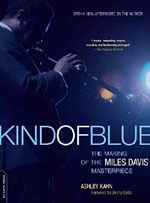 Getting past the controversy surrounding song ownership, one arrives at a masterpiece, painted with broad brushstrokes on a less-is-more canvas. As Evans gently delivers each chord at the top of the song, bassist Paul Chambers is right there with him on every statement. Jimmy Cobb gently enters with some of the softest brushwork imaginable and Davis' aching trumpet has an immediate emotional impact. Chambers becomes the rhythmic anchor for the group when Davis begins playing and things gently float along. Evans becomes a hair more forceful with his touch—though still relaxed and well suited to the musical environs he created—when it's his turn to solo. While Cannonball Adderley doesn't perform on this piece, John Coltrane does and provides a wonderful display that holds to the mood of the music, yet has a bit more momentum. Evans returns with for a second go-round, slightly less absorbing than the first, and Davis returns. Evans provides a romanticized conclusion and Chambers picks up his bow, ending with some faint arco work. This song proves to be the ultimate expression of musical color, both blue and green and so much more.
Getting past the controversy surrounding song ownership, one arrives at a masterpiece, painted with broad brushstrokes on a less-is-more canvas. As Evans gently delivers each chord at the top of the song, bassist Paul Chambers is right there with him on every statement. Jimmy Cobb gently enters with some of the softest brushwork imaginable and Davis' aching trumpet has an immediate emotional impact. Chambers becomes the rhythmic anchor for the group when Davis begins playing and things gently float along. Evans becomes a hair more forceful with his touch—though still relaxed and well suited to the musical environs he created—when it's his turn to solo. While Cannonball Adderley doesn't perform on this piece, John Coltrane does and provides a wonderful display that holds to the mood of the music, yet has a bit more momentum. Evans returns with for a second go-round, slightly less absorbing than the first, and Davis returns. Evans provides a romanticized conclusion and Chambers picks up his bow, ending with some faint arco work. This song proves to be the ultimate expression of musical color, both blue and green and so much more.
Stay tuned for more Old, New, Borrowed and Blue.
< Previous
Steve Swell: Sound Miracles
Next >
Live @ Charlie O's
Comments
Tags
For the Love of Jazz
 All About Jazz has been a pillar of jazz since 1995, championing it as an art form and, more importantly, supporting the musicians who create it. Our enduring commitment has made "AAJ" one of the most culturally important websites of its kind, read by hundreds of thousands of fans, musicians and industry figures every month.
All About Jazz has been a pillar of jazz since 1995, championing it as an art form and, more importantly, supporting the musicians who create it. Our enduring commitment has made "AAJ" one of the most culturally important websites of its kind, read by hundreds of thousands of fans, musicians and industry figures every month.





